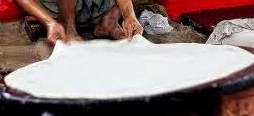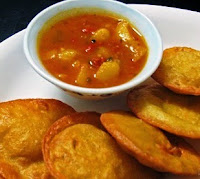J for Jadoh from Meghalaya

So next is J . And here we would talk of a very special Biryani - Jadoh prepared by Khasi tribes.
But before we talk about Jadoh, Jhal - muri is another local evening street food enjoyed in West Bengal , Bihar and jharkhand. Its nothing but the puffed rice with spices, vegetables, and chanachur or bhujia something like bhelpuri of mumbai.
Now Jadoh - Traditional Jadoh is a characteristic food of the Khasi tribe of Meghalaya. Here ‘Ja’ means rice and ‘Doh’ means meat. In Khasi food some or the other form of meat is a must. Vegetables here are generally consumed only as salads or for add on. The locals enjoy its original preparation called ‘Jadoh snam’ which is cooked in blood. Jadoh for a Khasi is like biryani for a North Indian, i.e. rice cooked with meat with their own special spices without use of much oil. In Jadoh snam the type of blood is chosen carefully as it can both enhance or destroy the taste.
Here we would talk about simple Pork Jadoh (Pork can be replaced with chicken or mutton)
Ingredients
Aditya Sinha
11.04.2020

So next is J . And here we would talk of a very special Biryani - Jadoh prepared by Khasi tribes.
But before we talk about Jadoh, Jhal - muri is another local evening street food enjoyed in West Bengal , Bihar and jharkhand. Its nothing but the puffed rice with spices, vegetables, and chanachur or bhujia something like bhelpuri of mumbai.
Now Jadoh - Traditional Jadoh is a characteristic food of the Khasi tribe of Meghalaya. Here ‘Ja’ means rice and ‘Doh’ means meat. In Khasi food some or the other form of meat is a must. Vegetables here are generally consumed only as salads or for add on. The locals enjoy its original preparation called ‘Jadoh snam’ which is cooked in blood. Jadoh for a Khasi is like biryani for a North Indian, i.e. rice cooked with meat with their own special spices without use of much oil. In Jadoh snam the type of blood is chosen carefully as it can both enhance or destroy the taste.
Here we would talk about simple Pork Jadoh (Pork can be replaced with chicken or mutton)
Ingredients
Rice – 2
cups (Short grain preferably)
Port –
300 gm with fat cut in small cubes. ( Alternatively chicken can be used, For
Veg it can be replaced totally with vegetables)
Onion –
1 Chopped
Ginger
Paste – 1 tbsp
Turmeric
Powder – ½ tsp
Black
Pepper powder – 1 tsp
Bay
leaves – 2
Vegetable
Oil – 2 tbsp
Salt as
per taste
Cilantro for garnishing
Preparation :
Wash
Rice and keep it aside for 15-20 mins
Heat oil
in a flat bottomed pan. Add onion and sauté till it becomes pink. Add ginger
paste, turmeric powder, black pepper and sauté .
Burn the
tip of the bay leaf and drop in the pan. Add Pork pieces and fry till turns
light brown. (Cook on low medium flame).
Add rice
(water strained out) and fry for 5 mins. Add salt and 4 cups of water and let it
simmer and cook till all become tender.
Garnish
with herbs (Cilantro / mint / Coriander ) and serve with fermented soya paste
and pork cooked in sesame (Tungrymbai & Dohneiiong respectively).
Other Recipe as part of A to Z challenge
A - Appam, B- Bhutte Ka Kees, C - Chhena Poda , D - Dhuska, E - Eromba F- Fish Curry (Goan) , G - Gulaoti Kebab, H - Halwa Paratha, I- Idiyappam
Other Genres in the Challenge :
Aditya Sinha
11.04.2020



















